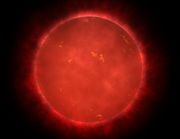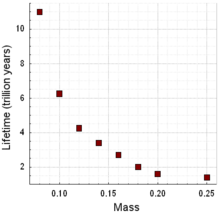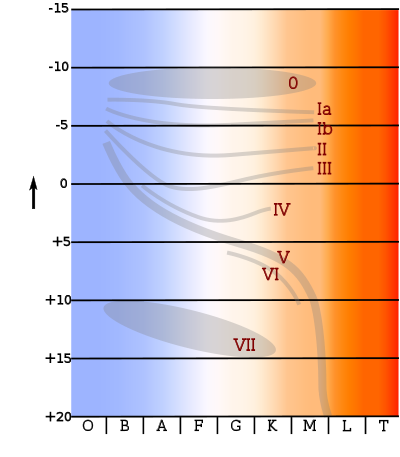Red dwarf

According to the Hertzsprung-Russell diagram, a red dwarf star is a small and relatively cool star, of the main sequence, either late K or M spectral type. They constitute the vast majority of stars and have a mass of less than one-half that of the Sun (down to about 0.075 solar masses, which are brown dwarfs) and a surface temperature of less than 3,500 K.
Contents |
Description and characteristics

Red dwarfs are very low mass stars with no more than 40% of the mass of the Sun.[2] Consequently they have relatively low temperatures in their cores and energy is generated at a slow rate through nuclear fusion of hydrogen into helium via the proton-proton (PP) chain mechanism. Thus these stars emit little light, sometimes as little as 1/10,000th that of the Sun. Even the largest red dwarf has only about 10% of the Sun's luminosity.[3]
In general red dwarfs transport energy from the core to the surface by convection. Convection occurs because of opacity of the interior, which has a relatively high density compared to the temperature. As a result, energy transfer via radiation is decreased, and instead convection is the main form of energy transport to the surface of the star.[4]
As red dwarfs are fully convective, helium does not accumulate at the core and, compared to larger stars such as the Sun, they can burn a larger proportion of their hydrogen before leaving the main sequence. As a result, red dwarfs have estimated lifespans longer than the estimated age of the universe, and stars with less than 0.8 solar masses have not had time to leave the main sequence. The lower the mass of a red dwarf, the longer the lifespan. It is believed that the lifespan of these stars exceeds the expected 10 billion year lifespan of the sun by the third or fourth power of the ratio of their masses to the solar mass; thus a red dwarf with 0.1 solar mass may continue burning for 10 trillion years.[5][2] As the proportion of hydrogen in a red dwarf is consumed, the rate of fusion declines and the core starts to contract. The gravitational energy generated by this size reduction is converted into heat, which is carried throughout the star by convection.[6]

The fact that red dwarfs and other low mass stars remain on the main sequence while more massive stars have moved off the main sequence allows the age of star clusters to be estimated by finding the mass at which the stars turn off the main sequence. This provides a lower, stellar, age limit to the Universe and also allows formation timescales to be placed upon the structures within the Milky Way galaxy, namely the Galactic halo and Galactic disk.
One mystery which has not been solved as of 2007 is the absence of red dwarf stars with no metals. (In astronomy, a metal is any element heavier than hydrogen or helium). The Big Bang model predicts the first generation of stars should have only hydrogen, helium, and trace amounts of lithium. If such stars included red dwarfs, they should still be observable today, but none have yet been identified. The preferred explanation is that without heavy elements only large and not yet observed population III stars can form, and these rapidly burn out leaving heavy elements which then allow for the formation of red dwarfs. Alternative explanations, such as that zero-metal red dwarfs are dim and could be few in number, are considered much less likely as they seem to conflict with stellar evolution models.
Red dwarfs are the most common star type in the Galaxy, at least in the neighborhood of the Sun. Proxima Centauri, the nearest star to the Sun, is a red dwarf (Type M5, apparent magnitude 11.05), as are twenty of the next thirty nearest. However, due to their low luminosity, individual red dwarfs cannot easily be observed. None are visible to the naked eye.[7]
Planets
Extrasolar planets were discovered orbiting the red dwarf Gliese 581 in 2005, about the mass of Neptune, or seventeen earth masses. It orbits just 6 million kilometers (0.04 AU) from its star, and so is estimated to have a surface temperature of 150 °C, despite the dimness of the star. In 2006, an even smaller extrasolar planet (only 5.5 times the mass of Earth) was found orbiting the red dwarf OGLE-2005-BLG-390L; it lies 390 million km (2.6 AU) from the star and its surface temperature is −220 °C (56 K).
In 2007, a new, potentially habitable extrasolar planet, Gliese 581 c, was found, orbiting Gliese 581. If the mass estimated by its discoverers (a team led by Stephane Udry), namely 5.03 times that of the Earth, is correct, it is the smallest extrasolar planet revolving around a normal star discovered to date. (There are smaller planets known around a neutron star, named PSR B1257+12.) The discoverers estimate its radius to be 1.5 times that of the Earth. This planet is within the habitable zone of Gliese 581, and is the most likely candidate for habitability of any extrasolar planet discovered so far.[8]
Habitability

Planetary habitability of red dwarf star systems is subject to some debate. In spite of their great numbers and long lifespans, there are several factors which may make life difficult on planets around a red dwarf star. First, planets in the habitable zone of a red dwarf would be so close to the parent star that they would likely be tidally locked. This would mean that one side would be in perpetual daylight and the other in eternal night. This could create enormous temperature variations from one side of the planet to the other. Such conditions would appear to make it difficult for forms of life similar to those on Earth to evolve. On the other hand, recent theories propose that either a thick atmosphere or planetary ocean could potentially circulate heat around such a planet.
In addition, red dwarfs emit most of their radiation as infrared light, while on Earth plants use energy mostly in the visible spectrum. Stellar variability in solar energy output may also have negative impacts on development of life. Red dwarfs are often covered by starspots, reducing stellar output by as much as 40% for months at a time. At other times, some red dwarfs, called flare stars, can emit gigantic flares, doubling their brightness in minutes. This variability may also make it difficult for life to develop and persist near a red dwarf star. Gibor Basri of the University of California, Berkeley claims a planet orbiting close to a red dwarf star could keep its atmosphere even if the star flares. [1]
See also
|
|
|
References
- ↑ Adams, Fred C.; Laughlin, Gregory; Graves, Genevieve J. M.. "Red Dwarfs and the End of the Main Sequence". Gravitational Collapse: From Massive Stars to Planets: 46–49, Revista Mexicana de Astronomía y Astrofísica. Retrieved on 2008-06-24.
- ↑ 2.0 2.1 Richmond, Michael (November 10, 2004). "Late stages of evolution for low-mass stars". Rochester Institute of Technology. Retrieved on 2007-09-19.
- ↑ Chabrier, G.; Baraffe, I.; Plez, B. (1996). "Mass-Luminosity Relationship and Lithium Depletion for Very Low Mass Stars". Astrophysical Journal Letters 459: L91–L94. doi:. http://adsabs.harvard.edu/abs/1996ApJ...459L..91C. Retrieved on 2007-09-19.
- ↑ Padmanabhan, Thanu (2001). Theoretical Astrophysics. Cambridge University Press. pp. pp. 96-99. ISBN 0521562414.
- ↑ Fred C. Adams and Gregory Laughlin (1996). "A Dying Universe: The Long Term Fate and Evolution of Astrophysical Objects".
- ↑ Koupelis, Theo (2007). In Quest of the Universe. Jones & Bartlett Publishers. ISBN 0763743879.
- ↑ http://kencroswell.com/thebrightestreddwarf.html "The Brightest Red Dwarf", by Ken Croswell (Accessed 6/7/08)
- ↑ SPACE.com - Major Discovery: New Planet Could Harbor Water and Life
- A. Burrows, W. B. Hubbard, D. Saumon, J. I. Lunine (1993). "An expanded set of brown dwarf and very low mass star models". Astrophysical Journal 406 (1): 158–171. doi:. http://adsabs.harvard.edu/abs/1998RPPh...61...77K.
- "VLT Interferometer Measures the Size of Proxima Centauri and Other Nearby Stars", European Southern Observatory (November 19, 2002). Retrieved on 2007-01-12.
- Neptune-Size Planet Orbiting Common Star Hints at Many More
External links
- Variable stars
- Stellar Flares - D. Montes, UCM.
- Red Dwarfs
- Red Star Rising : Small, cool stars may be hot spots for life - Scientific American (November 2005)